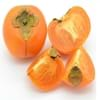Health Benefits
Arthritis treatment, Cancer prevention, Heart care
Good for diabetics, Improves well-being, Miraculin/miracle fruit makes sour things taste sweet
General Benefits
Anti-inflammatory properties, Cures cough, Cures fever, Digestive aid, Healing of wounds, Maintains healthy cholesterol level
Has taste modifying effect
Skin Benefits
Anti-aging benefits, Brightens and lightens complexion, Reduces wrinkles, Treatment of dark spots
NA
Hair Benefits
Promotes longer and healthier hair, Protects hair, Rejuvenates scalp, Shiny hair
NA
Allergy Symptoms
Abdominal cramps, Hives, Itching, Nausea, Wheezing
Itching, Skin rash
Side Effects
Allergic reaction, Skin rash, Possibly unsafe during pregnancy
Changes taste of food eaten after this fruit, Coagulation
Best Time to Eat
As a snack in the late afternoon, Eat the fresh ones, avoid mixing with any other foods, don't eat after meal., Morning time (before lunch), Strictly avoid empty stomach
As a snack in the late afternoon, Eat the fresh ones, avoid mixing with any other foods, don't eat after meal., Morning time (before lunch)
Protein to Carb Ratio
Not Available
Vitamin A (Retinol)
Not Available
Vitamin B1 (Thiamin)
Not Available
Vitamin B2 (Riboflavin)
Not Available
Vitamin B3 (Niacin)
Not Available
Vitamin B5 (Pantothenic Acid)
Not Available
Vitamin B6 (Pyridoxin)
Not Available
Vitamin B9 (Folic acid)
Not Available
Vitamin C (Ascorbic Acid)
Vitamin K (Phyllochinone)
Not Available
Lutein+Zeaxanthin
Not Available
Water Content
Not Available
Calories in Fresh Fruit with Peel
Not Available
Not Available
Calories in Fresh Fruit without Peel
Not Available
Calories in Frozen Form
Not Available
Not Available
Calories in Dried Form
Not Available
Calories in Canned Form
Not Available
Calories in Juice
Not Available
Calories in Jam
Not Available
Calories in Pie
Not Available
Varieties
Clementine, Dancy, King Mandarin, Murcott, Ponkan, Robinson, Satsuma and Sunburst
Gymnema Sylvestre and Thaumatococcus Daniellii
Inside Color
Orange
Greyish-white
Taste
Sweet-Sour
NA, Sweet
Origin
South-Eastern Asia
West Africa
Grows on
Not Available
Trees
Soil Type
Well-drained
Well-drained
Climatic Conditions
Sunny
Rainfall
Facts about
- It is known by another name ' Mandarin'.
- Oil extracted from its peel is used in various skin and hair care products.
- Tangerines is also known as the ‘Christmas Orange’ because it is used to stuff kids' stockings..
- The name 'Miracle' because of the magical experience you get after eating it.
- When you have lemon after eating this fruit, it tastes sweet as if it is added with sugar.
- It is also used as natural sweetener.
Cocktails
Not Available
Yes
Other Countries
Brazil, Iran, Italy, Japan, Korea, Morocco, Spain, Turkey
NA
Top Importer
China
Not Available
Top Exporter
Spain
United States of America
Botanical Name
Citrus reticulata
Synsepalum Dulcificum
Synonym
Citrus clementina or Citrus nobilis
Miracle Berry, Miraculous Berry and Sweet Berry
Subkingdom
Tracheobionta
Tracheobionta
Division
Magnoliophyta
NA
Subclass
Rosidae
Asteridae
Order
Sapindales
Ericales
Family
Rutaceae
Sapotaceae
Species
C. reticulata
S. dulcificum
Generic Group
Citrus fruit
Not Available
Difference Between Tangerine and Miracle fruit
We might think that Tangerine and Miracle fruit are similar with respect to nutritional value and health benefits. But the nutrient content of both fruits is different. Tangerine and Miracle fruit Facts such as their taste, shape, color, and size are also distinct. The difference between Tangerine and Miracle fruit is explained here.
The amount of calories in 100 gm of fresh Tangerine and Miracle fruit with peel is Not Available and Not Available and the amount of calories without peel is 53.00 kcal and Not Available respectively. Thus, Tangerine and Miracle fruit belong to Low Calorie Fruits and Low Calorie Fruits category.These fruits might or might not differ with respect to their scientific classification. The order of Tangerine and Miracle fruit is Sapindales and Ericales respectively. Tangerine belongs to Rutaceae family and Miracle fruit belongs to Sapotaceae family. Tangerine belongs to Citrus genus of C. reticulata species and Miracle fruit belongs to Synsepalum genus of S. dulcificum species. Beings plants, both fruits belong to Plantae Kingdom.









